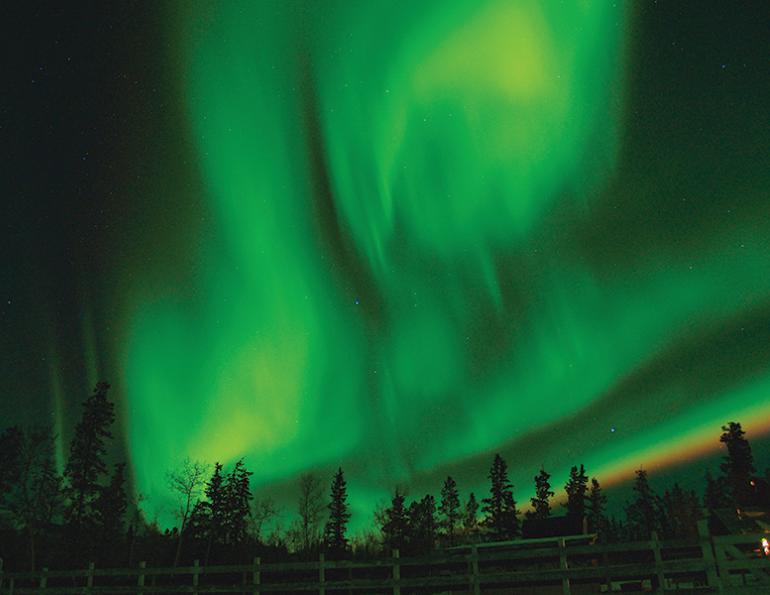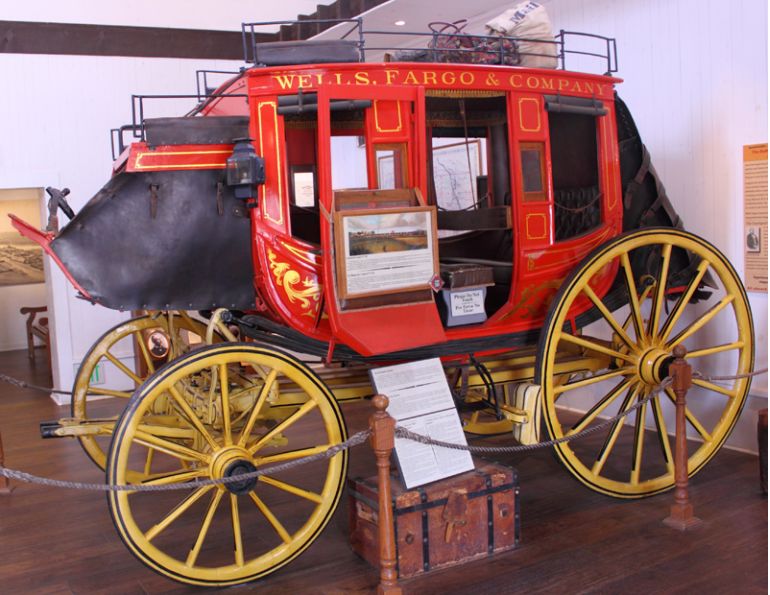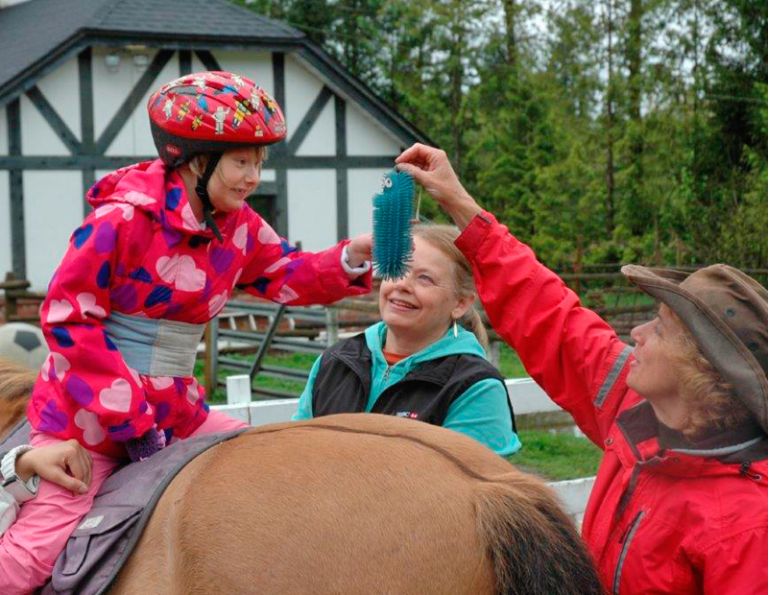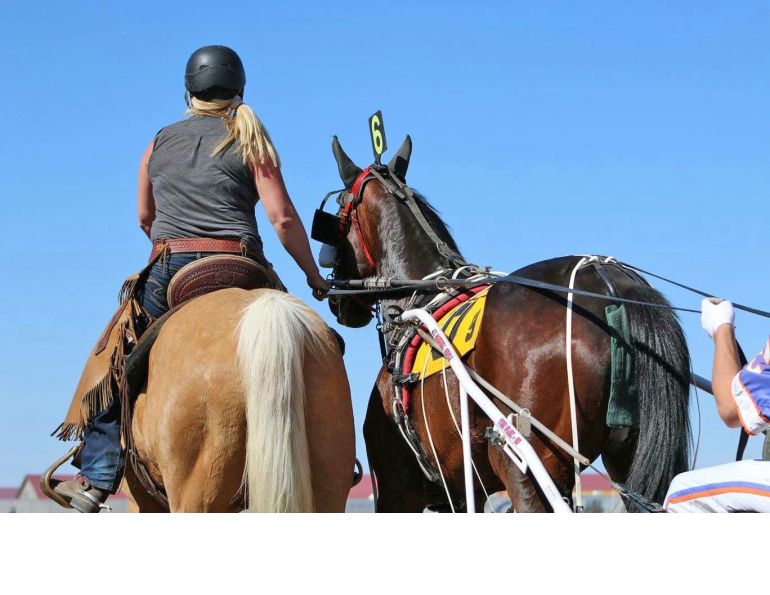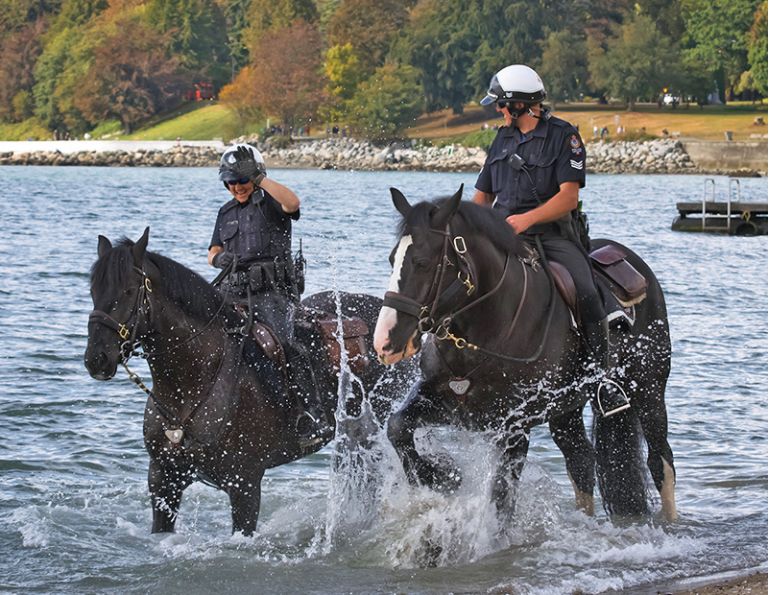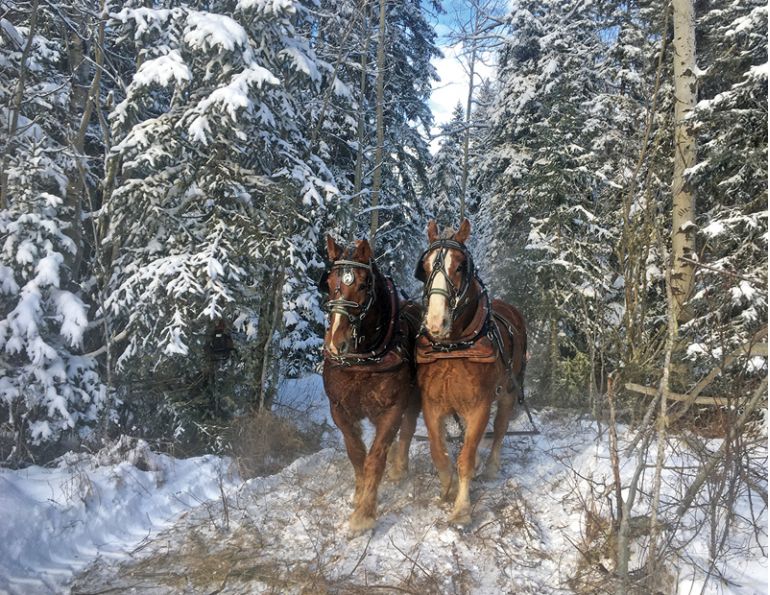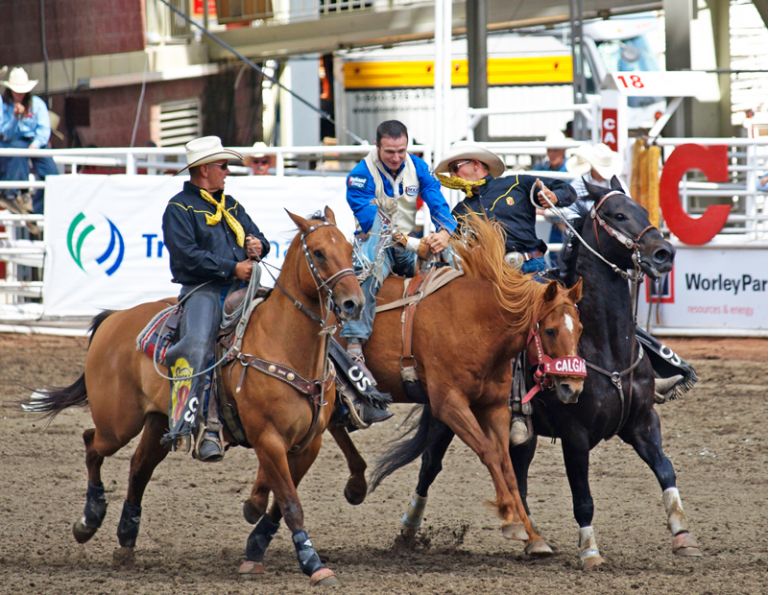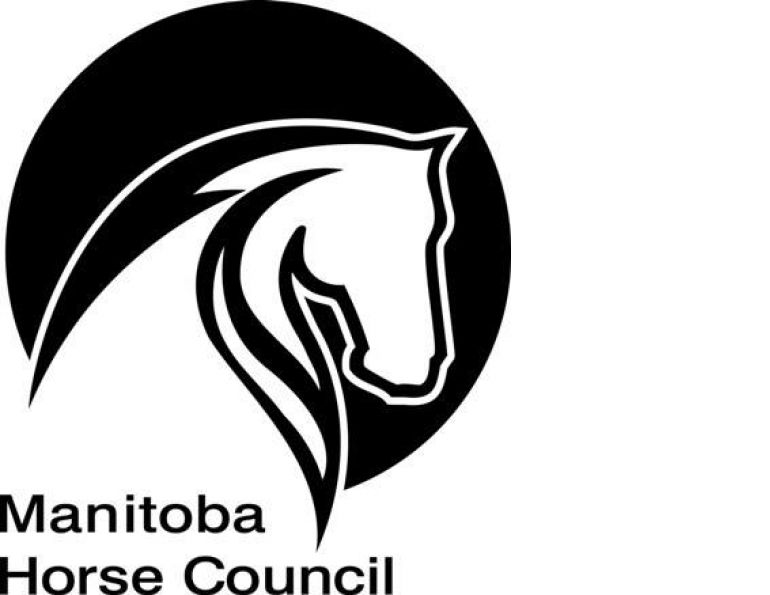Note: This article was published in 2016. Some details may be outdated.
Riding Beneath the Northern Lights
By Margaret Evans
The land is wide, gently rolling, and breathtaking. Distant mountains are white with glaciers, and form a rain shadow, making the grassland steppe extremely dry. In spite of this, the land is fertile and rich with vegetation. A gentle, dusty wind picks up, lifting the grasses, tundra flowers, herbs, sedges, mosses, lichen, shrub willows and birch in a whispering wave. The windborne loess, silky dust from boulders ground up by the glaciers and common throughout this unique northern world, is mixed with fine volcanic ash and will lay down the fertile soil for next year’s plant growth.
The horse stares. In the distance his herd grazes with mammoths, steppe bison, caribou, Dall sheep and camels. All are alert for the dangers from wolves, scimitar cats or short-faced bears. For so many years, the old stallion has followed the well-worn paths. But in this strange grassland world beset with violent storms, the trails are dissolving into spongy, destabilizing permafrost.
The stallion lies down to rest, folding his legs supportively beneath him. He feels the wear and tear as his bones creak with age. But in those bones lies the secret of his entire ancestry.
It would be some 700,000 years before Duane Froese, an earth sciences professor with the University of Alberta in Edmonton and his team excavated a metapodial (cannon) horse bone from permafrost in the Thistle Creek gold mine in west-central Yukon in 2003.

Skull of 700,000-year-old horse found in permafrost in Thistle Creek Gold Mine in Yukon in 2003. Photo: Duane Froese, University of Alberta, Edmonton
The team was hunting fossils embedded in permafrost while gathering data on the sediments that preserved them. Many other horse fossils found in Yukon had been pony-sized, but Froese and his team knew this find had come from a larger horse. What was exciting was that the fossil was from a time associated with Gold Run volcanic ash dating from some 735,000 years ago.
The horse had lived in the vast grassland region of Beringia that linked Yukon and Alaska with Siberia and northeast China. It was 1,000 kilometres wide and the size of Alberta and British Columbia. Beringia was not glaciated because the climate was so dry and snowfall was very light. It was an Arctic oasis supporting an ancient biodiversity of life.
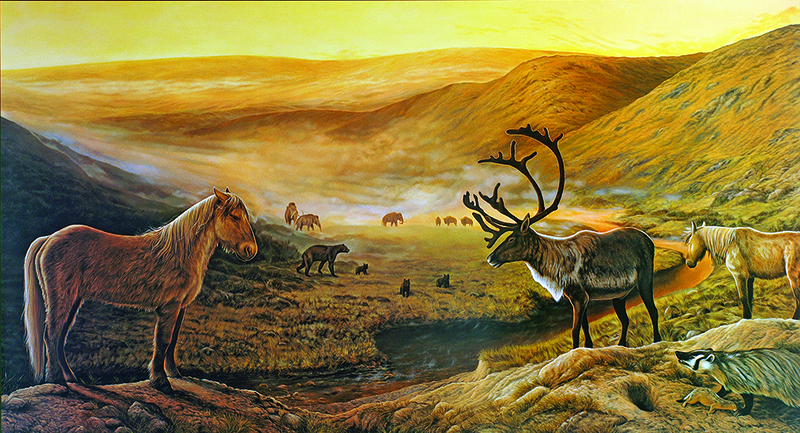
An artist's interpretation of Beringia with the Yukon horse (Equus lambei) in a Beringia landscape 11,000 years ago. Illustration by George Teichmann, courtesy of Government of Yukon
The horse’s preservation in the permafrost was exceptional with enough DNA preserved in the bone to decipher the genome of the ancient horse. It would be the oldest genome ever reconstructed. Scientists compared its DNA to that of a younger horse fossil (43,000 years old), five domestic horse breeds, Mongolian wild horse (Przewalski’s horse), and a donkey.
They learned that modern Equus, which gave rise to today’s horses, zebras, and asses, originated somewhere between four to four and one-half million years ago (twice as early as previously thought). Horse populations fluctuated many times over the last two million years due to severe climatic changes. They flourished in cool grasslands and dropped in population with encroaching boreal forests when the climate warmed. There was evidence of continuous selection on genes controlling the horse’s immune system and its ability to smell. And they found that the Mongolian wild horse separated from other horse lineages (those that would become the domestic horse) 38,000 to 72,000 years ago and had not interbred since, making Mongolia’s wild horse the world’s last truly wild horse.

The majority of horses in the Yukon live outside year-round and grow long, beautiful coats. Riders know how to dress for cold weather riding but, for the horse’s sake, recommend not riding if it’s colder than minus 20 degrees C. Pictured are Cara Worden (left) on Autumn and Janilyn Kooy on Mandolin after a winter trail ride. Photo courtesy of Janilyn Kooy
Yukon’s unique permafrost contains an incredible natural history rich in ancient horse and mammal fossils. Among the fossils are those of the curious stilt-legged horses found in Alaska and Yukon. Genetic and radiocarbon work continues on these fossils. These horses had legs similar to today’s Asiatic wild ass, the onager and the kiang. However, preliminary genetic results from these strange, ancient stilt-legged horses from Yukon suggest they may have been a species endemic to North America. The similarity in leg morphology shared by the North American stilt-legged horses and today’s Asian asses and kiangs may be the result of adaptations to arid climates so that each rose independently.
The last wild horse (Equus lambei) disappeared from Yukon just 10,000 years ago. It is testament to the fact that horses have not only survived but thrived in Yukon for millions of years. And they continue to do so today with people enjoying their horses in all kinds of equestrian activities.

Janilyn Kooy and Mandolin HBR (or aka Little Guy), trail riding by a field not far from the Yukon River. Photo: Cara Worden.
Fast forward to 2016. There are an estimated 651 horses in Yukon, based on a survey done by the Yukon Agriculture Branch, according to Vibeke Coates, president of the Equine Association of Yukon (EAY). There are no statistics for riders but EAY has had up to 179 members. Many riders, though, are less inclined to join organizations and simply enjoy their horses in a recreational way.
“The most popular activities would be trail riding, English riding lessons with local [Equestrian Canada] certified coaches and instructors, horsemanship/horse training clinics with local instructors as well as outside clinicians, Western style dressage, classical dressage, jumping, gymkhana, 4-H, and therapeutic riding,” says Coates. “There is an Annual General Performance show in Whitehorse and the General Performance Horse show in Watson Lake.”
“We usually have one large multi-discipline show a year,” says riding instructor Jody MacKenzie-Grieve. “This show usually includes games, gymkhana, trail, Western riding classes, English flat classes, hunter/jumper classes, etc. The intent of the show is to be inclusive and appeal to a wide range of interests, and there are between 50 and 100-plus entries. There are usually one or two dressage shows annually. In fact, a few years ago, Yukon hosted its first ever bronze level dressage show. There are usually one or two dressage and/or hunter/jumper schooling shows as well, and sometimes some of the clinicians that come up here to teach will also provide feedback in a schooling show-type situation. Often there are one or two gymkhana days as well.”

One large multi-discipline show is held each year, offering English and Western classes, gymkhana, and games. Left: Cara Worden and Autumn, a Quarter Horse-cross, ready to compete in a Dash For Cash gymkhana competition in Whitehorse at the Yukon Horse & Rider Association grounds (Photo by Janilyn Kooy). Right: Janilyn Kooy riding Donner’s Sensation to first place in the training level dressage test in 2013 (Photo by John Kooy).

Lessons and clinics help local riders meet their training and competition goals. Left: Yukon riders Spencer Sumanik on Deno and Maren Sinclair-Eckert on Carmen after a successful schooling session over fences (Photo courtesy of Inge Deehr Sumanik). Right: Magic, a Paint, pauses for a photo op at an Alan Kidd driving clinic at Gem’s Haven Stables (Photo by Janilyn Kooy).
MacKenzie-Grieve teaches mainly English disciplines although some of her clients also ride Western. Her clients, most of whom own their horses, come to her with a wide range of expectations from improving their competitive skills in dressage and jumping, to working on their riding abilities so they can enjoy their horses more. Some lessons continue on weekends during the winter months.
Therapeutic riding is offered at Freedom Trails Therapeutic Riding Association where they accommodate some 40 people of all ages (two years of age to over 70) split evenly among adults, children, and youth.
“Presently we are using about six horses and ponies for our mounted lessons,” says Executive Director, Judy Fortin. “It can vary from year to year. When looking for new horses we look for a horse with a good disposition with basic training at a minimum. Experienced riders work with the horses in the arena throughout the summer season and in the off-season, and we ride our therapy horses on the trail, making sure that they get a break from the arena. We are introducing ground work through an obstacle course in our lessons and training our horses with the obstacles.”
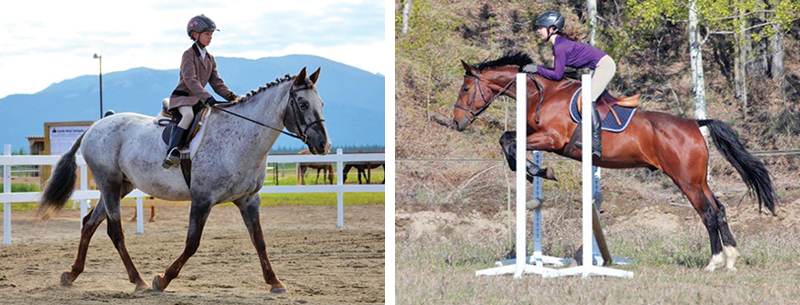
Left: Chitina, a 24-year-old Yukon-bred horse, is teaching the ropes to another young rider in a hunter course. Right: Jetta Bilsky and Bobby McGee prepare for the upcoming competition season. Photos courtesy of Inge Deehr Sumanik
Their summer program runs from the end of May for ten weeks and they accommodate groups in August and September. But what is unique to the program is a full-size horse simulator.
“The simulator has five gaits with lateral movement,” says Fortin. “It can be controlled by the instructor or by the rider’s reins and legs. We use the simulator in the summer on rained-out days and with program participants. The simulator is offered to the public in October through the winter and early spring.”
Most riders love the simulator, especially those nervous about riding. The simulator helps them overcome their fears, but whether a participant is on the simulator or a real horse, the team witnesses little miracles all the time.
“A rider was nervous about riding the horses,” says Fortin. “After the second lesson she agreed to try the simulator. Each week she became braver. It was a slow start but by mid-season she was riding the simulator without someone having to be by her side. She was noticeably proud of herself, as were we all.”
For young riders engaged with 4-H, activities continue from January to November and by all accounts their calendar is busy.
“We participate in the horse show and this year our Drill Ride Team performed,” says Joie McBryan, the A-Leader of the 4-H group. “We also host two gymkhanas that are open to the public. All the kids trail ride, some jump, and some do dressage. We present farm animals at a workshop day at the Whitehorse Weekly Fireweed market. We help at the Kinette’s annual Share the Spirit Campaign and participate in the North of 60 Agriculture Banquet every year by putting up a display. Two of our members speak to the audience on various 4-H related topics.”
The 4-H group, which includes Carolyn Campbell, Gail Riederer, Angelique Bjork, and Judy Linton, hold meetings at members’ farms and community facilities. A great deal of support comes from parents and family members, and they utilize local clinicians and resource people as part of their lesson plans.
MacKenzie-Grieve says a number of weekend clinics are also held each year with visiting coaches.
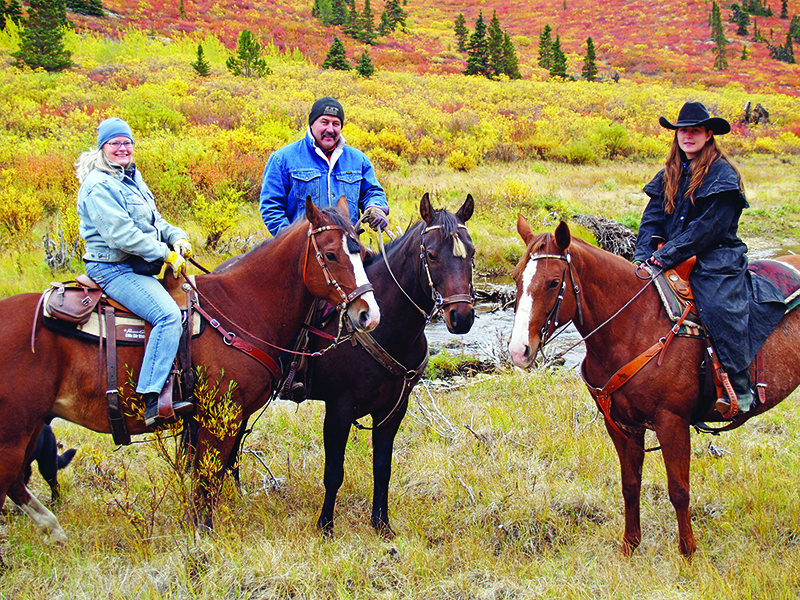
While there are no established equestrian trails in the Yukon, most recreational riders live on country residential property and can go trail riding right of their own backyard. L-R: Elaine Seier on Sonny, Guy Sevigny on Poco, and Angelique Bjork on Sky trail riding on the Annie Lake Road. Photo: Janilyn Kooy
“Most of the shows here are organized by the Yukon Horse and Rider Association,” she says, but adds that sometimes the schooling shows and gymkhana events are organized by individuals rather than the association. “In the past, the Yukon Horse and Rider Association maintained a show grounds located within the City of Whitehorse. A couple of years ago, the association lost it due to development of a new subdivision. Since that time, there has been more variability in terms of where the shows/events are held. Recently, most of the events have been held at the indoor arena.”
The indoor arena is run by the North Ridge Community Association and caters to activities with horses, dogs, sports, and recreational user groups.
“I am owner-operator of Northern Tempo Equestrian Centre based at the indoor riding arena,” says Inge Deehr Sumanik, who has been teaching in the Yukon for almost 30 years. “I have trained horses to fourth level and above in dressage and ridden in the hunter and jumper rings.”
Sumanik has clients who own their own horses, as well as ten school horses used by riders.
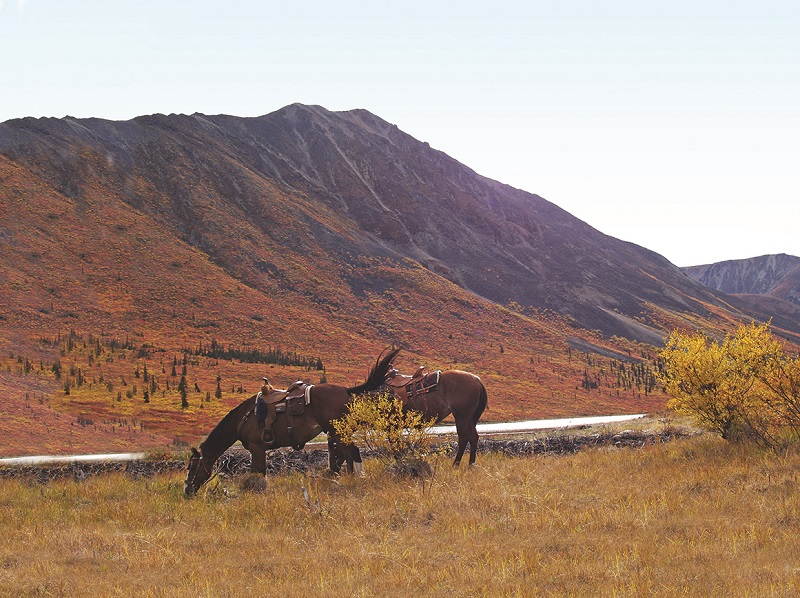
Quarter Horses Sonny and Sky, owned by Angelique Bjork, rest on a half day trail ride with a backdrop of colourful landscape. Photo: Janilyn Kooy
“We have taken some nice warmblood sport horses to shows in Alaska, BC, and Alberta as well as brought ribbons home with some Yukon-bred ponies and even a wonderful Fjord!” she says. “We have all breeds here. I teach riders on some nice warmbloods, some Quarter Horses, some fabulous ponies, and a few Thoroughbreds. I ride my own Alberta-bred warmbloods. Sometimes the horses require a year to adjust to the early winter, but for the most part the horses transition well into our country.”
“Many people have their own outdoor riding arenas of various sizes and with various footings,” says Coates. “By many, I mean at least 30. Most recreational horse owners live on country residential property.”
Holistic riding is also an option for horse owners and Claudia Ellen Heath offers lessons that present a learning curve for both riders and horses.
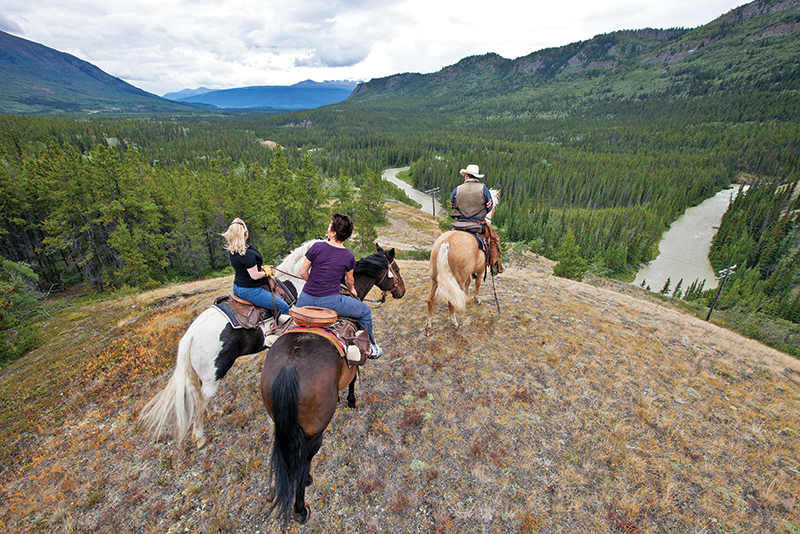
Tourists enjoy horseback riding near Spirit Lake in the South Klondike Highway area. Photo: ©Government of Yukon/J Kennedy
“My clients all focus primarily on recreational riding and their relationship with their horses,” says Heath. “People need to be able to be as kind to themselves as they want to be with their horses. They need to be able to forgive themselves and be non-judgmental with themselves as well as with their horse.”
Heath is an architect by profession, so, given time priorities, she aims not to have more than five clients at a time. She offers lessons in horsemanship, groundwork, liberty work, and riding as well as all-round horse care including barefoot trimming.
“I use my own horses for lessons as much as I work with people with their own horses,” she says. “Usually people really get hooked once they catch on, and have up to several lessons per week.”
Her property, Yakamaw Farm, is located on 30 acres in Haines Junction west of Whitehorse. In 2015, they moved to the Whitehorse vicinity in order to be closer to more recreational opportunities. “My horses are boarded on Windy Ridge, a farm of several hundred acres along the Takhini River where it joins the Yukon River in Whitehorse. The horses are on winter pasture and are turned out all year.”
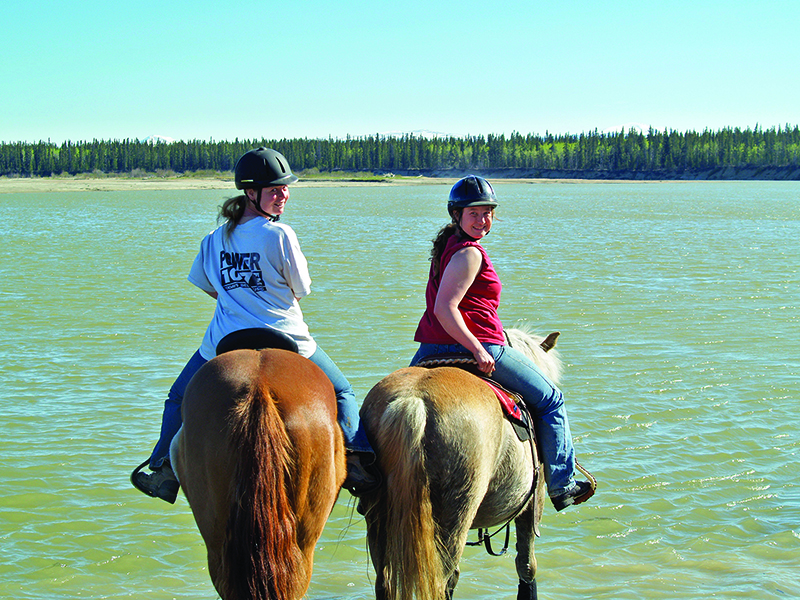
Cara Worden on Prince and Janilyn Kooy on Mandolin enjoy a fun ride in the Yukon River. Photo: Med
Riding in the Yukon is uniquely different from many other regions in Canada with perhaps more appealing opportunities than riders in southern provinces experience. The summer months with their long daylight hours allow riders to enjoy their horses well into the late evening, even riding at midnight when it is still virtually daylight. Access to trails is seldom a problem and it is easy for riders to hop on their horses and head up a trail right out of their backyard.
“Many of the trails in the bush are firewood cutting trails,” says Coates. “There are also mining roads all over. There are no established equestrian trails that I know of. The big game outfitters have trails into their base camps but these are remote and often in rough country.”
Riders in southern Canada might think that winter with its extreme weather, lack of light, frozen footing, and subzero temperatures would be a huge deterrent. But Yukoners and their horses are more than up to the task despite the challenges.
“For those of us still enjoying the outdoor winter riding experience, temperature and light play key roles,” says MacKenzie-Grieve. “Personally, if it is light out and warmer than minus 15 degrees Celsius I try to ride, but some people try to get out even when it is colder than that. People try to avoid sweating up the horses and making them breathe too hard. They make sure the level of activity is suitable for the level of fitness of the horse and generally just try to enjoy the horses and keep them in reasonable shape. Many of us think about it as exercising during the winter rather than training.”
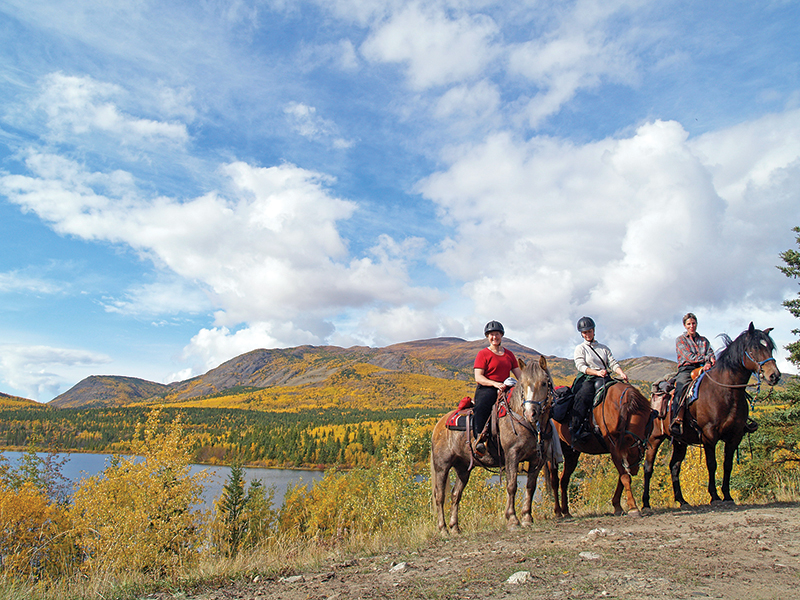
Janilyn Kooy on Mandolin HBR, Cara Worden on Autumn, and Elizabeth Weigand on Amigo were enjoying a trail ride to Mud Lake when this photo was taken by hikers passing by.
When asked if there are particular breeds that thrive better in the Yukon than others, she said that had she been asked that question 20 years ago, she would have advised not to bring a Thoroughbred to the Yukon. “Things have changed, though. Our winters are generally not as cold as they used to be and the cold snaps we do get don’t last as long. Our climate here is pretty similar to Edmonton, except that the winter is longer. At least in the Whitehorse area it is usually not that bad.”
It is rare for horse owners to bring their horses into a barn at night on a regular basis. Stalls are usually open to the outside so that horses have free choice to go in and out. Most horses tend to be easy keepers with extra feed to combat the cold, while some are blanketed.
“Most horses live outside all year long,” agrees Coates. “There are a very few that are stabled inside at night. Most horses are not blanketed unless their health is compromised in some way - they are old or sick. Therefore, the horses grow long beautiful, shiny coats. When being ridden, the horses can get quite overheated and start to sweat, so care has to be taken that they don’t get chilled. It’s also not a good idea to exercise a horse hard when it’s minus 20 degrees Celsius as it can be hard on their lungs. Usually footing is pretty good in the winter because the snow is cold and dry.”
Coates says that riders bundle up for trail riding and it can be quite comfortable up to about minus 20 degrees Celsius if it is sunny and there is no wind. Daylight will be an issue in the fall as the days get shorter really fast.
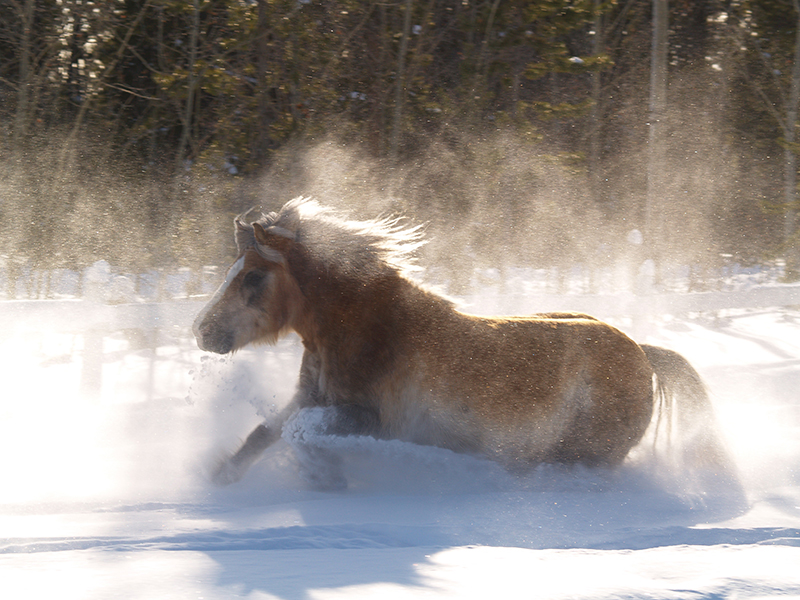
The Haflinger, Mandolin HBR, owned by Janilyn Kooy, playing in the snow. Photo: Janilyn Kooy
“For myself, I will train my horses outside to about minus 10 degrees Celsius. This is a factor of age. The biggest problem is [eye] glasses freezing up. Technical clothes are readily available as cross-country skiing is very popular as well as snowmobiling, so it is easy to keep the core temperature warm. The challenge is the hands. I was able to use SSG Digital gloves outside all winter last year with over-mitts with hand heaters in them when not actively riding.”
Coates says a special challenge can be getting a horse dry after being ridden in an indoor arena and before turning it out.
“Hair dryers are often used,” she says. “It is possible to dry a horse that lives outside and is hauled to the indoor arena for clinics and occasional riding by putting a couple of fleece blankets on for the ride home and then removing them and putting a turnout shell on until the next day when the sun is shining. Dry snow is also good for a sweaty horse to roll in - it absorbs the sweat and then the horse shakes it off. If it is minus 30 degrees Celsius then usually people do not ride their horses in the indoor arena. It’s too much of a temperature differential.”
Temperature swings can be a real issue. “Very critical for horses are big temperature swings of 20 to 30 degrees over 24 hours,” says Heath. Spring and fall bring those day and night temperature differences, and dramatic warm-ups can occur mid-winter. “Colic is a huge risk in that time. I also believe that not being able to graze and browse makes colic that much more likely. Horses that are in a small pen being fed hay all winter are prime candidates for colic in Yukon.”

Janilyn Kooy on Bramo in front of a field at Lebarge Ranch, Yukon. Photo courtesy of Janilyn Kooy
Keeping horses fit and healthy is a key component of avoiding the need for veterinary or specialist care. There is less horse-related infrastructure in Yukon such as surgical facilities, multiple indoor riding facilities, and access to specialists. Construction for any barn project is more expensive since most supplies have to be shipped in. Accessing sufficient hay for the winter starts in spring and early summer when people order their supply for the following winter.
“We do have some local feed and hay suppliers as well but their costs are often also high because they pay more for fuel, fertilizer, etc., than those in the south,” says MacKenzie-Grieve. “On average our hay costs between $13 and $15 for a 55-plus pound bale that is shipped up from northern Alberta or BC. Local hay tends to be slightly less expensive. Our 2015 summer was not anywhere near as dry as it was in many parts of western Canada. We actually had a fair bit of rain at the time when farmers were trying to get hay off. Because of the microclimates around here, the rain affected some farmers but not others.”
People might think of Yukon as a distant land, but there is much more here that unites people in kinship with their horses than divides by distance.
“We are not limited in Yukon,” says Sumanik. “It used to be a remote place with limited access to knowledge, skill building, and horses. With the indoor arena we are able to regularly bring up excellent coaches and clinicians. They build local coaches and riders.”
And the immense landscape and beauty of Yukon can change a person’s perspective and make all the challenges so worthwhile.
“Because we are in the North we do not see riding as competition, but rather that competition is a step in the ladder of training, a measure of success, and a marker of new goals,” says Sumanik. “There is nothing better than riding outside under the evening sun with eagles flying overhead, and huge views.”
For more information, please visit:
- Yukon Beringia Interpretive Centre
- Horsin Around Yukon
- Yukon's Indoor Arena
- Equine Association of Yukon
- Freedom Trails Therapeutic Riding Association
Horse Community Journals thanks the horse community of the Yukon for providing the information and photographs for this article. Ride on!
Main photo: The Yukon experience: “A friend and I would ride on full moon nights and sometimes see the northern lights - very beautiful,” says Janilyn Kooy. Photo courtesy of Janilyn Kooy
Note: This article was published in 2016. Some details may be outdated.



